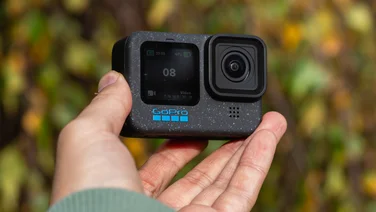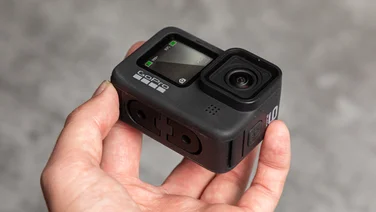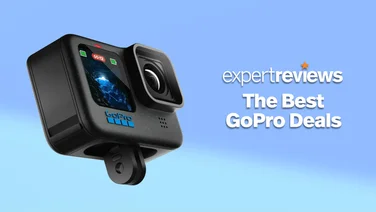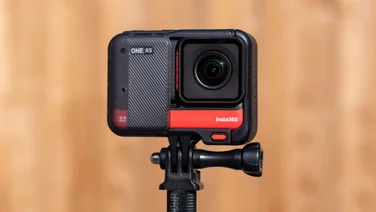To help us provide you with free impartial advice, we may earn a commission if you buy through links on our site. Learn more







- 4K video recording at 60fps
- Great image stabilisation
- Same excellent design as Hero 5
- Much more expensive than Hero 5
- Poor image quality in low light
- App needs polish
GoPro has ruled the roost in the action camera for an age, but with improving smartphone cameras and waterproofing, the reasons for buying one are falling by the day. Why spend over £400 on a separate camera when your phone can shoot video that’s nearly as good and that you can take out and about in most conditions?
GoPro Hero 6 Black review: What you need to know
It turns out there are plenty of reasons, which I’ll get into further on in this review. For now, though, all you need to know is that this is currently the best camera in GoPro’s lineup and, despite the fact that it looks identical to its predecessor – the now-cheaper Hero5 – it’s a significant step forwards.







New features include the ability to shoot 4K footage at 60fps (previously limited to 30fps) and to shoot electronically stabilised video at up to 4K 30fps, plus there’s improved stabilisation in general and marginally better image quality.
The Hero 6 Black doesn’t replace the Hero 5 in the range, though; instead, the latter is now cheaper, offering those on a smaller budget the chance to enjoy great action camera quality at a more competitive price.
READ NEXT: Xiaomi Yi 4K+ action camera review
GoPro Hero 6 Black review: Price and competition
The price of the GoPro Hero 6 Black has fallen from the heady heights of its £499 launch price to a more palatable £380, but that’s still a lot to pay for any kind of action camera.
Alternatives include the GoPro Hero 5 Black, which is now £270 and Xiaomi’s Yi 4K+, which shoots at much higher bit rates than the GoPro cameras. The latter isn’t natively waterproof, though; you have to pop it in a case if you want to go swimming or surfing with it.
GoPro Hero 6 Black review: Design and features
This is an easy one: if you’ve ever seen, held or shot video with a GoPro Hero 5 Black you’ll be right at home with the Hero 6, because it’s physically identical. It’s the same rectangular shape and has the same square protruding lens housing on the front.
The shutter and power buttons are in the same locations on the top right and right-hand side and, as before, there’s a 2in touchscreen on the rear, which can be used to frame your shots and change settings.
The flaps and connections are the same, too: on the right-hand side, a small one covers the Mini-HDMI and USB Type-C ports and underneath a larger one covering the battery and Micro USB slot. There’s still no tripod thread on the body of the camera, which remains a big irritation.







But it is all natively waterproof to 10m, which means you don’t have to pop it in a case before getting it wet and those identical dimensions mean all the accessories from the Hero 5 will fit the Hero 6.
This might not be a big deal for consumers, the majority of whom won’t be upgrading from the still-adequate Hero 5, but it’s an important consideration for professional videographers who might well have a collection of Hero 5 Blacks and accompanying accessories. GoPro’s decision to keep the Hero 6 Black the same physically means they won’t have to splurge on a bunch of new cases, fittings and batteries.
The big new feature for the GoPro Hero 6, however, is inside: it has a new processor – called the GP1 – and this delivers, GoPro claims, twice the performance of its predecessor.
What can you do with this? The first benefit is 4K recording at a super-smooth 60fps (or 50fps for those living in PAL land) where the Hero 5 was limited to a maximum 30fps in this mode. As with the Hero 5 Black, you don’t get to use electronic image stabilisation (EIS) in this mode, but the good news is you can with 4K 30fps or 25fps.
It records this footage in HEVC format (H.265), the same more-efficient format used in 2017’s new iPhones, which is good in some ways because files take up less space in storage, but bad in others because you may need to convert it before using them with your existing editing and playback software.







You may also find that your computer needs an upgrade to play them back – my 2013 15in MacBook Pro struggled to play footage at anything better than a choppy slideshow.
Still, in other modes, the camera records in regular H.264 format, which is much easier to deal with, including the new slow-motion 240fps frame rate, which can be applied to 1080p footage and below. And there’s plenty more to play around with besides, with additional resolutions of 1440p and 720p available and frame rates down to 24fps.
The final big improvement the Hero 6 Black offers over its predecessor, though, needs no special hardware to appreciate: better image stabilisation. In the same vein as many of 2017’s best smartphones, this gives your videos a superbly smooth, near-Steadicam stability.
As with all electronic stabilisation, you sacrifice some of the frame, but the payoff is more than worth it: handheld shots when you’re standing still are incredibly stable and even walking shots are reasonably smooth, though there’s still some evidence of shimmer as your feet hit the ground.
In fact, I’d say if you stick to 4K 30fps and below, there’s no need to supplement the Hero 6 with a gimbal-based stabiliser like the Karma Grip at all. It really is that good.
GoPro Hero6 review: Software and app
Alas, although the usability of the touchscreen and camera is pretty good, the app isn’t the greatest piece of work. I couldn’t get it to pair with the GoPro at all with my Huawei Mate 10 Pro and, after nearly an hour of head-scratching and trying various different things, I switched to the Pixel 2 XL, which – after a little encouragement eventually let me pair with the camera.
The app connects via 2.4GHz or 5GHz Wi-Fi and it can be used for changing settings, previewing and recording video from a remote location, taking pictures and downloading footage afterwards. And yes, it does work, but even after connecting successfully I still had problems. The preview works fine, for instance, in portrait mode, but spin the phone around and the view disappears off to the left. Not ideal.

I also found the camera itself would freeze at random and, no matter what I did, it would always lock up irretrievably when I set the resolution and frame rate to 2.7K 4:3 at 30fps and I had to remove the battery to get it going again.
The desktop “Quik” software is better, fortunately. It has a simple interface, lets you do basic editing and overlay stuff such as your speed, elevation, GPS track and compass heading on top of footage before exporting. It also pulls out automatic highlights based on the camera’s interpretation of movement and various other parameters and will put together a quick and dirty edit for you with very little effort.
GoPro Hero6 review: Image quality and battery life
Surprisingly, there’s not much to say about the image quality that hasn’t been said before. Aside from the camera’s new 4K 60fps mode, image quality is pretty much as you were before. The colours are perhaps a tad richer here and there, but largely the GoPro’s big strengths and big weaknesses remain the same.
It’s great when you have ample light and its reproduction of colour and auto-exposures are brilliant. Sunsets look glorious, especially in timelapse mode and there’s enough bit rate to make sense of complicated textures such as distant tree foliage, foaming water and pisted snow without the camera having a complete fit.
And for those who need to colour match video footage between different cameras, the GoPro Hero 6 Black’s ProTune mode is a godsend, providing fine-grained control over ISO sensitivity levels, shutter speed, white balance and colour balance, while RAW image capture give keen photographers a similar level of control over stills.
Where the GoPro Hero 6 doesn’t impress is in low light. Ugly grain is visible in stills as well as video footage if you so much as let it sniff the inside of a building on a cold grey winter’s day and don’t even think about taking it out on a dark night. The one saving grace is that you can control the ISO and shutter speed to at least reduce the worst of it.
Battery life is pretty good, though. In two hours of use, I was able to shoot nearly an hour of 4K 30fps footage with GPS and EIS enabled before the battery gave out and needed topping up. Fortunately, that doesn’t take too long and reaches 100% from empty in just over an hour. If you’re going to be taking the cameras on location with you, though, you’ll need a handful of precharged spare batteries to get you through a day.
GoPro Hero 6 review: Verdict
In all, the GoPro Hero 6 is a cracking camera, but whether you should buy the GoPro Hero 6 is a tricky question. On the one hand, it’s an excellent all-rounder. It has all the features you need, coupled with great image quality, superb image stabilisation, waterproofing, ruggedness and admirable on-camera ease of use.
On the other hand, it’s very expensive and not a huge amount better than the Hero 5, especially given the huge differential in price, while rivals are coming up on the rails, quality-wise.
If it was me with this much money burning a hole in my pocket I’d seriously consider buying the Hero 5 instead and using the money saved to purchase a handheld, motorised gimbal – or even put it towards the purchase of a decent drone like the DJI Mavic Pro.







